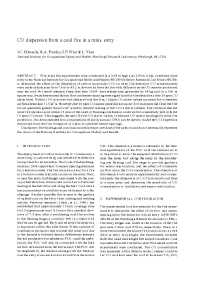Mining Publication: CO Dispersion from a Coal Fire in a Mine Entry
Original creation date: June 2006
Five mine fire experiments were conducted in a 2.08-m-high, 2.90-m-wide ventilated mine entry in NIOSH's Safety Research Coal Mine to determine the effect of the dispersion of carbon monoxide (CO) on mine fire detection. CO measurements were made at distances from 7.6 to 45.2 m downwind from the fire with diffusion-mode CO sensors positioned near the roof. For small-intensity fires, less than 30-kW heat release rate, generated by 14-kg coal in a 0.61-m square tray, it was determined that airflow and sensor spacing were significant for fire detection at the 10-ppm CO alarm level. Within 15.0 m downwind distance from the fire, 10-ppm CO alarm values occurred for volumetric airflows less than 11.5 cubic meters/sec. However, the 10-ppm CO alarm value did not occur 30.0 m downwind from the fire for air quantities greater than 6.2 cubic meters/sec due to dilutive mixing of the CO in the airstream. The criterion that the mine fire alarms occur within 15 min of the onset of flaming combustion could not be consistently met with the 10-ppm CO alarm. This suggests the use of lower CO alarm values or reduced CO sensor spacings for mine fire protection. It is demonstrated how computational fluid dynamics (CFD) can be used to model the CO dispersion downwind from the fire in support of a plan to optimize sensor spacings.
Authors: JC Edwards, RA Franks, GF Friel, L Yuan
Conference Paper - June 2006
NIOSHTIC2 Number: 20030334
Proceedings of the 11th U.S./North American Mine Ventilation Symposium, University Park, Pennsylvania, June 5-7, 2006. Mutmansky JM, Ramani RV. eds., London, U.K.: Taylor & Francis Group, 2006 Jun; :511-517
See Also
- CO and CO2 Emissions from Spontaneous Heating of Coal Under Different Ventilation Rates
- Evaluation of Smoke and Gas Sensor Responses for Fires of Common Mine Combustibles
- Experimental and Modeling Investigation of the Effect of Ventilation on Smoke Rollback in a Mine Entry
- Factors Affecting ANFO Fumes Production
- In-depth Survey Report: Control Technology for Environmental Enclosures - The Effect of Wind Speed Upon Aerosol Penetration Into an Enclosure at Clean Air Filter, Defiance, IA
- Laboratory Testing To Quantify Dust Entrainment During Shield Advance
- Measurement of Airflow in a Simulated Underground Mine Environment Using an Ultrasonic Anemometer
- Monitoring and Removal of CO in Blasting Operations
- Smoke, Carbon Monoxide, and Hydrogen Chloride Production from the Pyrolysis of Conveyor Belting and Brattice Cloth
- Sonic Anemometer Airflow Monitoring Technique for Use in Underground Mines
- Page last reviewed: 9/21/2012
- Page last updated: 9/21/2012
- Content source: National Institute for Occupational Safety and Health, Mining Program


 ShareCompartir
ShareCompartir
